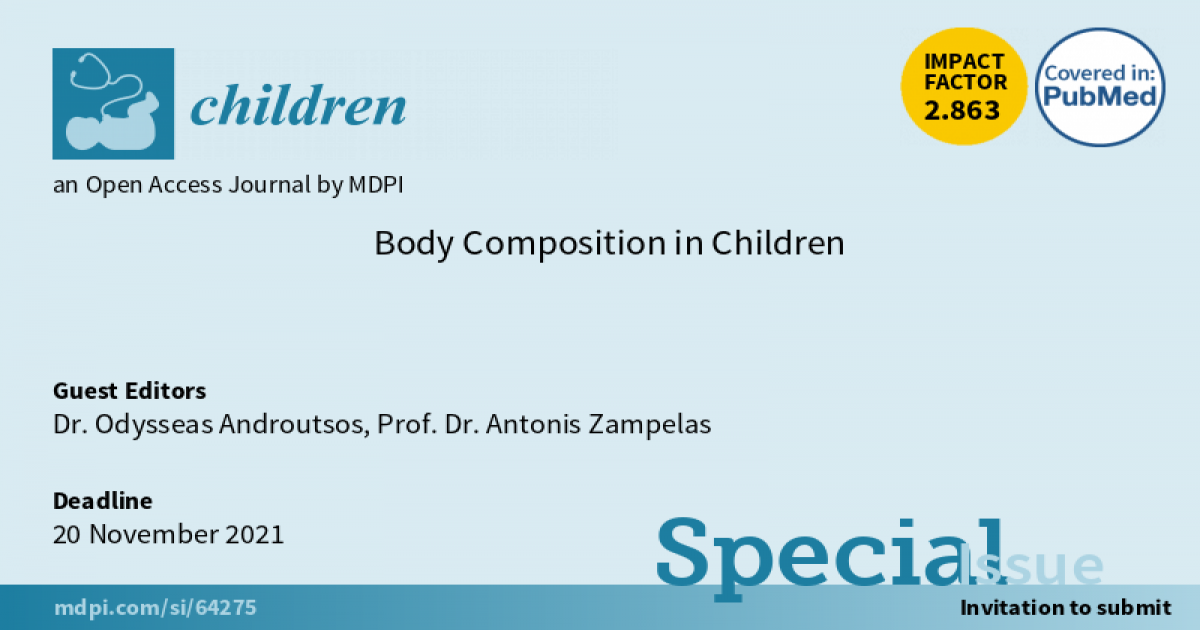- 2.1Impact Factor
- 3.8CiteScore
- 16 daysTime to First Decision
Body Composition in Children
This special issue belongs to the section “Global Pediatric Health“.
Special Issue Information
Dear Colleagues,
Body composition plays an important role in children’s health and infuences energy requirements. It is determined by a large number of factors, including genes, age, gender, ethnicity, perinatal factors, energy balance (nutrition, physical activity, sedentary behavior) and health status, while it is assessed by various complex techniques (e.g., four compartment model) or more surrogate methods (anthropometry, bioelectrical impedance analysis, etc.).
Developing new tools, standardizing the assessment methods, and evaluating the validity and applicability of existing or novel methods to assess body composition in wide population groups of children and/or pediatric patients would optimize nutritional assessement and enable the scientific community to overcome important barriers related to its applicability in public health actions and clinical practice.
Furthermore, undestanding the underlying mechanisms linking body composition and health is essential. Studies exploring the pathways through which adiposity induces changes of health indices are needed to tackle the effects of obesity in children’s metabolic profile and in the development of chronic diseases across the lifespan. On the other hand, studies aiming to shed more light on the interplay among undernutrition, nutritional status, prognosis, quality of life, and health indices in pediatric patients, as well as to elucidate how body composition influences the effectiveness of therapies in children, are required to improve health care.
Similarly, clarifying if and how various types of interventions (lifestyle, pharmacological, surgical, enteral/parenteral feeding, etc.) can improve children’s body composition in healthy or ill children is necessary to develop effective strategies to tackle both sides of malnutrition in childhood.
The Special Issue on “Body Composition in Children” aims to host articles that will focus on healthy or ill pediatric populations and will advance current knowledge on the role of body composition on children’s health, explore the determinants of malnutrition across childhood, present new techniques or test the validity of existing tools to assess body composition and provide new insights into how interventions can improve body composition in children and adolescents.
Dr. Odysseas Androutsos
Prof. Dr. Antonis Zampelas
Guest Editors
Manuscript Submission Information
Manuscripts should be submitted online at www.mdpi.com by registering and logging in to this website. Once you are registered, click here to go to the submission form. Manuscripts can be submitted until the deadline. All submissions that pass pre-check are peer-reviewed. Accepted papers will be published continuously in the journal (as soon as accepted) and will be listed together on the special issue website. Research articles, review articles as well as short communications are invited. For planned papers, a title and short abstract (about 250 words) can be sent to the Editorial Office for assessment.
Submitted manuscripts should not have been published previously, nor be under consideration for publication elsewhere (except conference proceedings papers). All manuscripts are thoroughly refereed through a single-blind peer-review process. A guide for authors and other relevant information for submission of manuscripts is available on the Instructions for Authors page. Children is an international peer-reviewed open access monthly journal published by MDPI.
Please visit the Instructions for Authors page before submitting a manuscript. The Article Processing Charge (APC) for publication in this open access journal is 2400 CHF (Swiss Francs). Submitted papers should be well formatted and use good English. Authors may use MDPI's English editing service prior to publication or during author revisions.
Keywords
- Body composition
- Growth
- Malnutrition
- Undernutrition
- Wasting
- Stunting
- Underweight
- Overweight
- Obesity

Benefits of Publishing in a Special Issue
- Ease of navigation: Grouping papers by topic helps scholars navigate broad scope journals more efficiently.
- Greater discoverability: Special Issues support the reach and impact of scientific research. Articles in Special Issues are more discoverable and cited more frequently.
- Expansion of research network: Special Issues facilitate connections among authors, fostering scientific collaborations.
- External promotion: Articles in Special Issues are often promoted through the journal's social media, increasing their visibility.
- e-Book format: Special Issues with more than 10 articles can be published as dedicated e-books, ensuring wide and rapid dissemination.

